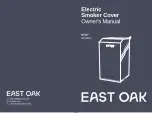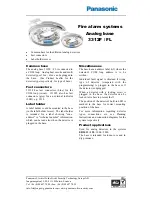
SS-400-006
3 I56-3535-002R
[4.4]SECuRE THE DuCT DETECTOR TO THE DuCT
Use two (rectangular configuration) or three (square configuration) of the pro-
vided sheet metal screws to screw the duct detector to the duct .
CAUTION: Do not overtighten the screws .
CAUTION
Do not overtighten the screws .
[5]SamPLInG TuBE InSTaLLaTIOn
[5.1]SamPLInG TuBE SELECTIOn
The sampling tube must be purchased separately . Order the correct length, as
specified in Table 1, for width of the duct where it will be installed . The sam-
pling tube length must extend at least
2
/
3
across the duct width for optimal
performance .
The sampling tube is always installed with the air inlet holes facing into the
air flow . To assist proper installation, the tube’s connector is marked with an
arrow . Make sure the sampling tube is mounted so that the arrow points into
the airflow as shown in Figure 5 . Mounting the detector housing in a vertical
orientation is acceptable provided that the air flows directly into the sam-
pling tube holes as indicated in Figure 5 . The sampling tube and exhaust tube
can be mounted in either housing connection as long as the exhaust tube is
mounted downstream from the sampling tube .
TaBLE 1. SamPLInG TuBES RECOmmEnDED fOR
DIffEREnT DuCT wIDTHS:
Outside Duct Width
Sampling Tube Recommended*
Up to 1 ft .
DST1
1 to 2 ft .
DST1 .5
2 to 4 ft .
DST3
4 to 8 ft .
DST5
8 to 12 ft .
DST10 (2-piece)
*Must extend a minimum of
2
⁄
3
the duct width
fIGuRE 5. aIR DuCT DETECTOR SamPLInG TuBE:
SAMPLING TUBE ENDCAP
ARROW MUST FACE
INTO AIR FLOW
AIR FLOW
DIRECTION
CAUTION:
The sampling tube end cap, included with the detector, is critical
to proper operation of the duct smoke detector . The end cap is needed to
create the proper air flow to the sensor of the duct smoke detector . Once any
sampling tube length adjustments are made, plug the end of the sampling
tube with the provided end cap .
A plastic exhaust tube is included with the unit to be installed if needed . In-
stall into the housing connection that is downstream from the sampling tube
connection . The exhaust tube can be installed from the front of the detector
or the back . A longer 1 foot exhaust tube, model ETX, is available as an acces-
sory in cases where the molded exhaust tube does not extend at least 2 inches
into the duct .
[5.2]SamPLInG TuBE InSTaLLaTIOn
1 . For tubes shorter than the width of the duct, slide the sampling tube,
with installed end cap, into the housing connection that meets the air-
flow first . Position the tube so that the arrow points into the airflow as
shown in Figure 5 . Per NFPA sampling tubes over 3 feet long should be
supported at the end opposite of the duct detector . In ducts wider than 8
feet, work must be performed inside the duct to couple the other section
of the sampling tube to the section already installed using the ½ inch
conduit fitting supplied . Make sure that the holes on both sections of the
air inlet sampling tube are lined up and facing into the airflow .
2 . For tubes longer than the width of the air duct, the tube should extend
out of the opposite side of the duct . Drill a ¾ inch hole in the duct op-
posite the hole already cut for the sampling tube . Ensure that the sam-
pling tube is angled downward from the duct smoke detector to allow for
moisture drainage away from the detector . The sampling tube should be
angled at least
1
⁄
4
” downward for every 12” of duct width . There should
be 10 to 12 holes spaced as evenly as possible across the width of the
duct . If there are more than 2 holes in the section of the tube extending
out of the duct, select a shorter tube using Table 1 . Otherwise, trim the
tube to leave approximately 1 to 2 inches extending outside the duct .
Plug the end with the end cap and tape closed any holes in the protrud-
ing section of the tube . Be sure to seal the duct where the tube protrudes .
WARNING
In no case should more than 2 air inlet holes be cut off the tube . There must
be a minimum of 10 holes in the tube exposed to the air stream .
[5.3]mODIfICaTIOnS Of SamPLInG TuBES
There may be applications where duct widths are not what is specified for the
installation . In such cases, it is permissible to modify a sampling tube that is
longer than necessary to span the duct width .
Use a 0 .193-inch diameter (#10) drill and add the appropriate number of holes
so that the total number of holes exposed to the air flow in the duct is 10 to 12 .
Space the additional holes as evenly as possible over the length of the tube .
CAUTION:
This procedure should only be used as a temporary fix . It is not
intended as a permanent substitute for ordering the correct length tubes .
[5.4]REmOTE SamPLInG TuBE InSTaLLaTIOn
The detector arrangement can also incorporate the remote mounting of the
sampling tube and/or exhaust tube . In this case both the detector, sampling
tube and exhaust tube (if included) should be rigidly mounted to withstand
the pressure and vibrations caused by the air velocity . The location of the
detector’s sampling tube should be such that there is uniform airflow in the
cross section area .
Pressure differential across the sampling and exhaust ports in the detector hous-
ing shall be verified to be between 0 .01 and 1 .11 inches of water . Do so by mea-
suring the pressure difference between the inlet and outlet ports on the detector
housing using a manometer as described in the Measurement Tests sectiont of
this manual .
[6]mEaSuREmEnT TESTS
[6.1]aIR fLOw
The DNRHS is designed to operate over an extended air speed range of 300
to 4000 FPM . To verify sufficient sampling of ducted air, turn the air handler
on and use a manometer to measure the differential pressure between the two
sampling tubes . The differential pressure should measure at least 0 .01 inches
of water and no more than 1 .11 inches of water . Because most commercially
available manometers cannot accurately measure very low pressure differen-
tials, applications with less than 500 FPM of duct air speed may require one
of the following: 1) the use of a current-sourcing pressure transmitter (Dwyer
Series 607) or 2) the use of aerosol smoke, see below for test descriptions .
[6.2]LOw fLOw aIR fLOw TEST uSInG DwyER SERIES 607
DIffEREnTIaL PRESSuRE TRanSmITTER
Verify the air speed of the duct using an anemometer . Air speed must be at
least 300 FPM . Wire the Dwyer transmitter as shown in
Figure 5
. Connect the
leads of the meter to either side of the 1000
Ω
resistor . Allow unit to warm up
HIGH
LOW
9 VOLT
BATTERY
9 VOLT
BATTERY
9 VOLT
BATTERY
TO SAMPLING TUBE
TO EXHAUST TUBE
DIFFERENTIAL
PRESSURE
TRANSMITTER
MODEL #607-01
15 TO 36
VDC SUPPLY
1000 OHM 5%
1 WATT RESISTOR
VOLT METER FLUKE
MODEL 87 OR
EQUIVALENT
+
–
HO-163-01
HO-551-00
fIGuRE 6: PROCEDuRE fOR VERIfyInG aIR fLOw


























